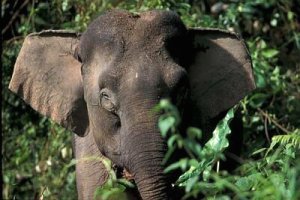|
| Query: Borneo rhino | Result: 45th of 59 | |
Pygmy elephant in Sabah proven to be a new subspecies
| Subject: | Pygmy elephant in Sabah proven to be a new subspecies
| |

| Resolution: 300x200
File Size: 19641 Bytes
Upload Date: 2007:09:06 21:32:46
|
Pygmy elephant in Sabah proven to be a new subspecies
Thursday September 4, 2003
BY SUSAN TAM
[Photo] The Borneo pygmy elephant which has been confirmed to a new subspecies found in Sabah.
PETALING JAYA: They are smaller, tamer and more mild tempered compared with other Asian elephants and were discovered in Sabah.
Following DNA tests they have now been confirmed as a new subspecies of Borneo “Pygmy Elephants.”
Yesterday, WWF-Malaysia chairman Tengku Zainal Adlin congratulated the Sabah Wildlife Department on the discovery of the new variety.
Tengku Zainal said in a statement that the DNA tests confirmed that the elephants were a distinct subspecies and had different characteristics from their cousins found on mainland Asia and Sumatra.
“For a start, they are relatively tame and mild tempered when compared with other Asian elephants. Borneo’s elephants are also smaller in size.
He said with permission from the department, WWF’s Asian Rhino and Elephant Action Strategy (Areas) programme had set out to collect the elephant’s dung for studies on the animals’ migratory patterns along the Kinabatangan river conducted in the past couple of years.
“Samples were collected from different parts of Sabah, namely the lower Kinabatangan, Kalabakan Forest Reserve and Ulu Segama Forest Reserve.
“The mucus adhering to fresh elephant dung contains epithelial intestinal cells which are used for DNA testing. DNA samples are unique to each individual. This technique of obtaining DNA does not harm the elephants, as they are not captured for testing,” he said.
He said the samples were then sent to Columbia University’s Department of Ecology, Evolution and Environmental Biology for DNA analysis and compared with samples from Asian elephants from other countries.
He said the department and WWF’s Areas concurred with Columbia University that these elephants were a distinct subspecies.
Tengku Zainal said from the research done by the university, the DNA evidence showed that the elephants were isolated about 300,000 years ago from their cousins on mainland Asia and Sumatra.
“During that period, these elephants became smaller with relatively larger ears, longer tails and relatively straight tusks,” he added.
“The evolutionary history of Borneo’s elephants justifies their recognition as a separate evolutionary significant unit.
“Borneo’s elephants are genetically distinct and this rejects the argument they were introduced to the island,” he said.
He said it was important to highlight the conservation of these elephants to ensure their survival.
“They should not be crossbred with other Asian elephants, and it is recommended that research on their reproductive rates, juvenile survival and other indicators of detrimental effects of inbreeding be carried out next,” he said.
Source: http://thestar.com.my/news/
|
Comments |
|---|
| | Guest |
|
Scientific Name: Elephas maximus borneensis Deraniyagala, 1950
Common Names: Borneo elephant, Borneo pygmy elephant |
^o^
Animal Pictures Archive for smart phones
^o^
|
|
|